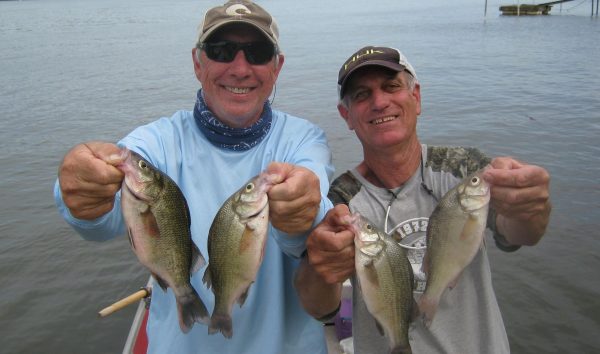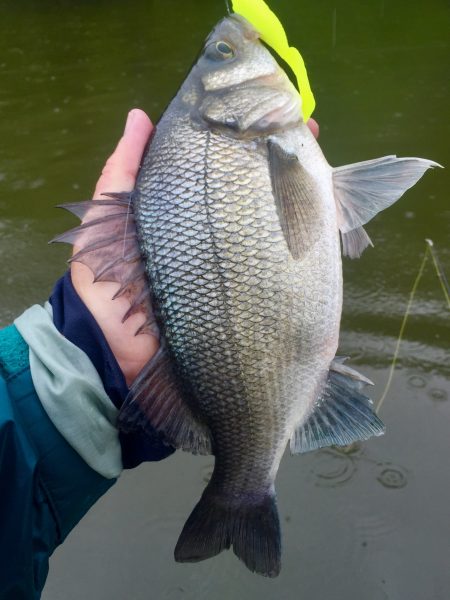
Seasonal White Perch Patterns
Ready to get back to fishing? White perch are ready and waiting for you. They can be found almost anywhere in the Chesapeake Bay. A relative of striped bass, white perch occupy a range of depths and habitats. Oyster bars, drop-offs and artificial reefs all hold white perch. Seasonal patterns are easy to figure out given that white perch stay in the bay and its rivers their entire lives. Places to find white perch include the main stem of the bay, river mouths and remote upriver tributaries. They can be readily caught from shore or by boat, either anchored or drifting. Easy to catch and good to eat, white perch season is open all year.

Spring is prime time to fish for white perch. Upper Bay water temperatures need to be near 55 degrees for the spawn to start. White perch move to fresh water during the spawning run and seek hard, gravelly, or sandy bottoms. According to fish biologists, male white perch mature by age two, and females are ready to reproduce by age three. Juvenile white perch remain in the rivers of their birth until they get big enough to venture into the open bay. White perch can live up to ten years and grow to over 14 inches, but most don’t live that long or get that big.
Maryland has no minimum size or creel limit as long as the perch are caught on hook and line. However, there is not much meat on little white perch under nine inches long, so only keep the bigger ones and release the rest. The Susquehanna River below Lapidum and above the I-95 Bridge is a good spot to find fish because this is where large packs of perch come to spawn.

Summer is also a great time to catch white perch. If you catch one, there are sure to be more around because white perch are a schooling species. Productive upper bay white perch spots include the waters off of Hart-Miller Island, Man O’War Shoal, and the knolls at the mouth of the Patapsco River. Podickery Point at the mouth of the Magothy River consistently holds white perch. The bay bridge pilings are always worth a try. The mouth of the Chester River, Swan Point, Hodges Bar and Tolchester Bar are other well-known white perch hotspots.
Fall is maybe the best time to catch big white perch because they’ve been growing all summer. The silver colored fish are feeding heavily to help get them through the cold winter months. White perch are active through November and into December.
Hungry white perch can be caught on live bait such as bloodworms, grass shrimp, and minnows. They will also bite an array of artificial lures including beetle spins, plastic grubs, and small crankbaits. Light to medium spinning rod and reel combos are popular. White perch tackle is simple. Connect a top and bottom rig to the main line. Use small hooks such as a #6 Eagle Claw bait-holder style. Add a piece of bloodworm or grass shrimp and you’re ready to fish. Small hooks and small pieces of bait work better than big hooks and big pieces of bait. Start with a one-ounce sinker. Be sure the sinker is on the bottom because perch are on the bottom. If it’s not, use a heavier weight. It’s important to hold the rod level and keep the slack out of the line.
Sometimes you get one fish on the top hook and one on the bottom. Don’t be surprised if you catch a catfish or a striped bass. For many kids, a white perch is often their first fish. Maryland Department of Natural Resources has a First Fish Award certificate available on their website. Go to www.dnr.maryland.gov/fisheries/Pages/youth to print one free.
Please be sure to adhere to all COVID-19 Guidelines when you are fishing or engaging in outdoors activities. Visit the Maryland Department of Natural Resources’ fishing season calendar before heading out.
Our online COMPASS portal provides 24/7 self-service access to our entire product catalog of recreational licenses, permits, and stamps plus many other Maryland Department of Natural Resources programs.
To help plan your adventure on the waters of Maryland, visit Fishandhuntmaryland.com.
Tim Campbell, a Maryland native, has fished the Chesapeake Bay for many years. He is an award winning member of the Mason-Dixon Outdoor Writers Association.